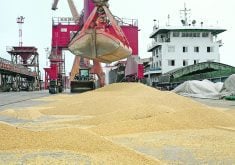China’s new tariff on canola seed comes as forecasts for this year’s crop are increasing, putting downward pressure on canola futures.
Only a month ago, analysts forecasted that the crop would be smaller and the carry-in would be small, leading to an expectation of tight total supply and the need to ration exports.
The July Agriculture Canada monthly outlook forecast only six million tonnes of exports in 2025-26, down from close to 10 million in the crop year just ended.
Read Also

Chinese offer complicates canola marketing
Recently the Chinese ambassador indicated that there would be a potential deal between Canada and China regarding the current tariff war.
Under that scenario, the loss of the China market, while troublesome, mighty not be overwhelming.
But after a very dry start, the weather in much of Western Canada improved in mid July.
The latest Agriculture Canada forecast for August incorporates remote sensing and climate data to the end of July.
Seeded area is down from last year, but the department’s yield forecast is above average at about 42 bushels per acre, similar to 2020-21.
This is still an early forecast and things could change, but for now, the forecast is for production at 20.1 million tonnes, up from 19.2 million in the July report, an increase of 900,000 tonnes from the previous month.
With that extra production, the department increased its export forecast by a million tonnes to seven million.
That is achievable even without sales to China, but it might mean selling more to the United Arab Emirates and Mexico as well as lower-paying buyers Pakistan and Bangladesh.
But even that scenario needs context.
China had restrictions on importing Canadian canola in the years 2019-20, 2020-21 and 2021-22, and in those years, some of these alternative markets bought a greater percentage of Canada’s exports.
However, that situation overlapped a period when global oilseed prices were strong because world soybean production stagnated.
The United States had poor crops in 2019 and 2020.
In 2019, Canada had a terrible canola crop in and in the same year, Brazil’s soy crop was poor. Argentina had problems in 2022.
At the same time, agriculture commodities jumped higher when Russia invaded Ukraine in 2022.
Also, a sharp drop in palm oil exports because of poor weather and COVID-related labour shortages in 2021-22 forced palm oil prices to record highs.
So although Canada had to sell more canola to places like Pakistan and Bangladesh in the years of China restrictions, even those price-sensitive markets had to pay fairly strong prices.
But now, global oilseed supply has recovered the past two years and oilseed prices have dropped.
While canola has its own price drivers, it also is strongly influenced by soybeans and soy oil.
And at this time of year, much rides on the American crop.
The U.S. Department of Agriculture forecasts above trend yield for the American soybean crop, up almost six per cent from last year, and the crop condition is better than average.
That partly offsets the sharp seven per cent reduction in planted acreage, resulting in a crop forecast of 4.29 billion bushels, down only two per cent from last year.
The expectation that more soybean oil will go into renewable diesel has helped to keep soybean prices stable this summer, but there is also downward pressure from the trade battle between the U.S. and China. China is meeting most of its current soy import needs from South America.
So overall, the global oilseed complex is at a lower price level and is likely to stay that way, barring a late season disaster for the American crop or a weather problem this winter in South America.
One way to avoid selling canola into lower price markets is to expand domestic processing.
Agriculture Canada forecasts a small processing increase to 11.8 million tonnes from 11.5 million last year.
There will be no capacity issue in reaching that number.
Cargill in Regina and Louis Dreyfus Co. in Yorkton, Sask., have each added a million tonnes in new crush capacity.
The crush total will depend on demand, and the potential for that to increase is uncertain.
U.S. biofuel policy developments have been generally positive for Canadian crushers that export canola oil south, but there are still undecided issues that might yet severely limit the amount of Canadian product in American renewable fuel.
Time will tell.
As for the Canadian biofuel market, it marked a milestone this month as Imperial Oil opened its Strathcona renewable diesel refinery near Edmonton, the largest such plant in Canada, with a capacity of 20,000 barrels per day.
It is expected to use canola oil as part of its feedstock, potentially at capacity using the oil from 2.5 million tonnes of canola.
The canola industry wants the federal government to make it harder to import and use cheap used cooking oil in renewable diesel.
In 2024, 23 per cent of the feedstock used to make renewable diesel in Canada was used cooking oil.















